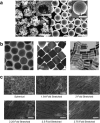Designing biomaterials with immunomodulatory properties for tissue engineering and regenerative medicine
- PMID: 28932817
- PMCID: PMC5579731
- DOI: 10.1002/btm2.10063
Designing biomaterials with immunomodulatory properties for tissue engineering and regenerative medicine
Abstract
Recent research in the vaccine and immunotherapy fields has revealed that biomaterials have the ability to activate immune pathways, even in the absence of other immune-stimulating signals. Intriguingly, new studies reveal these responses are influenced by the physicochemical properties of the material. Nearly all of this work has been done in the vaccine and immunotherapy fields, but there is tremendous opportunity to apply this same knowledge to tissue engineering and regenerative medicine. This review discusses recent findings that reveal how material properties-size, shape, chemical functionality-impact immune response, and links these changes to emerging opportunities in tissue engineering and regenerative medicine. We begin by discussing what has been learned from studies conducted in the contexts of vaccines and immunotherapies. Next, research is highlighted that elucidates the properties of materials that polarize innate immune cells, including macrophages and dendritic cells, toward either inflammatory or wound healing phenotypes. We also discuss recent studies demonstrating that scaffolds used in tissue engineering applications can influence cells of the adaptive immune system-B and T cell lymphocytes-to promote regenerative tissue microenvironments. Through greater study of the intrinsic immunogenic features of implantable materials and scaffolds, new translational opportunities will arise to better control tissue engineering and regenerative medicine applications.
Keywords: biomaterial; immunology; intrinsic immunogenicity; nanoparticle and microparticle; regenerative medicine; tissue engineering; vaccine and immunotherapy.
Figures








Similar articles
-
T lymphocytes as critical mediators in tissue regeneration, fibrosis, and the foreign body response.Acta Biomater. 2021 Oct 1;133:17-33. doi: 10.1016/j.actbio.2021.04.023. Epub 2021 Apr 24. Acta Biomater. 2021. PMID: 33905946 Review.
-
Harnessing Biomaterials for Immunomodulatory-Driven Tissue Engineering.Regen Eng Transl Med. 2023;9(2):224-239. doi: 10.1007/s40883-022-00279-6. Epub 2022 Sep 29. Regen Eng Transl Med. 2023. PMID: 37333620 Free PMC article. Review.
-
Immunomodulation of Skin Repair: Cell-Based Therapeutic Strategies for Skin Replacement (A Comprehensive Review).Biomedicines. 2022 Jan 6;10(1):118. doi: 10.3390/biomedicines10010118. Biomedicines. 2022. PMID: 35052797 Free PMC article. Review.
-
The role of biomaterials and scaffolds in immune responses in regenerative medicine: macrophage phenotype modulation by biomaterial properties and scaffold architectures.Biomater Sci. 2021 Dec 7;9(24):8090-8110. doi: 10.1039/d1bm00840d. Biomater Sci. 2021. PMID: 34762077 Review.
-
Interplay between biomaterials and the immune system: Challenges and opportunities in regenerative medicine.Acta Biomater. 2023 Jan 1;155:1-18. doi: 10.1016/j.actbio.2022.11.003. Epub 2022 Nov 7. Acta Biomater. 2023. PMID: 36356914 Review.
Cited by
-
Wound Closure Promotion by Leucine-Based Pseudo-Proteins: An In Vitro Study.Int J Mol Sci. 2024 Sep 6;25(17):9641. doi: 10.3390/ijms25179641. Int J Mol Sci. 2024. PMID: 39273588 Free PMC article.
-
Challenges and Pitfalls of Research Designs Involving Magnesium-Based Biomaterials: An Overview.Int J Mol Sci. 2024 Jun 5;25(11):6242. doi: 10.3390/ijms25116242. Int J Mol Sci. 2024. PMID: 38892430 Free PMC article. Review.
-
Electrically conductive biopolymer-based hydrogels and fibrous materials fabricated using 3D printing and electrospinning for cardiac tissue engineering.Bioact Mater. 2025 Jun 9;51:650-719. doi: 10.1016/j.bioactmat.2025.05.014. eCollection 2025 Sep. Bioact Mater. 2025. PMID: 40546729 Free PMC article. Review.
-
Applications of Bioengineered Polymer in the Field of Nano-Based Drug Delivery.ACS Omega. 2023 Dec 18;9(1):81-96. doi: 10.1021/acsomega.3c07356. eCollection 2024 Jan 9. ACS Omega. 2023. PMID: 38222544 Free PMC article. Review.
-
The Role of Interstitial Fluid Pressure in Cerebral Porous Biomaterial Integration.Brain Sci. 2022 Mar 22;12(4):417. doi: 10.3390/brainsci12040417. Brain Sci. 2022. PMID: 35447953 Free PMC article.
References
Publication types
LinkOut - more resources
Full Text Sources
Other Literature Sources

